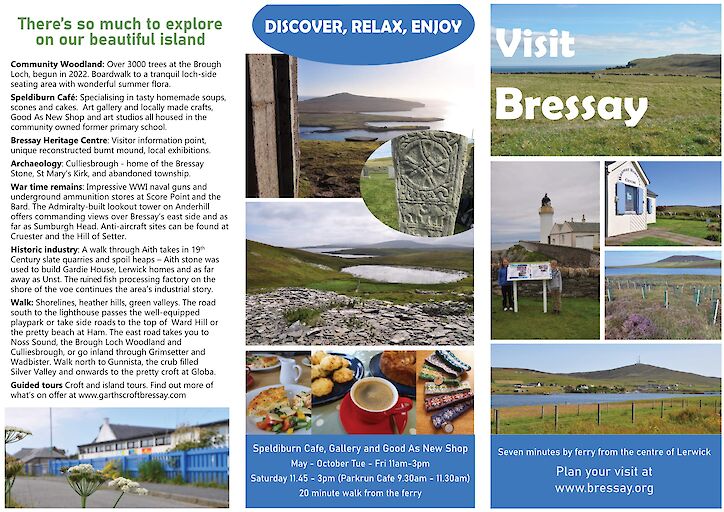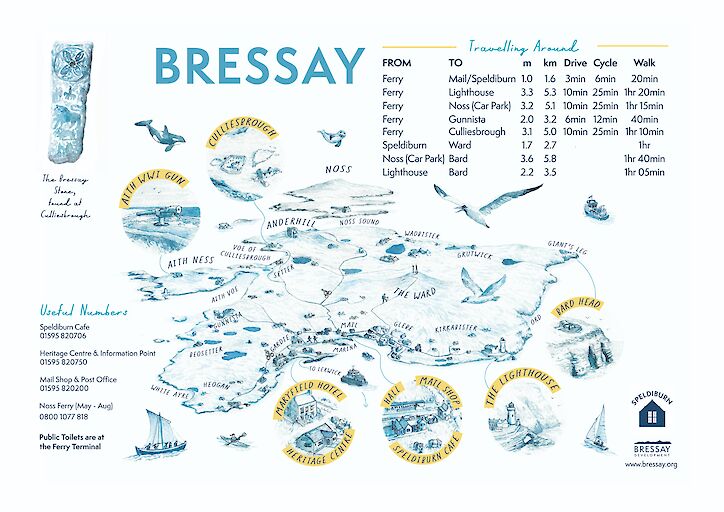Bressay is an island on Shetland’s east side, a seven-minute ferry journey from Lerwick, Shetland’s capital town. Bressay’s easy access from Lerwick makes it an ideal choice for a day trip, but to enjoy its best walks, historic sites and stunning scenery will require a longer stay.
Bressay has fantastic natural resources, a great café, restaurant and Heritage Centre and is ideal for walking and cycling. Its lovely croft-dotted landscape has areas of interesting geology, wild bird, seal and otter populations, beaches and sites of historical interest.
View the Visit Bressay Leaflet below.
Eating out, visitor centres and amenities
Speldiburn Café
Situated in the newly refurbished former primary school along with a community library and Good As New Shop, the Speldiburn Café offers freshly made soups, light lunches and home baked cakes. The Café's exhibition space showcases work by local and visiting artists.
Maryfield restaurant & bar (01595 820203)
A licensed hotel and restaurant with a bar, situated close to the Bressay ferry terminal, offering a varied menu with the option of pre-booking a fresh seafood platter. The Maryfield also holds curry nights, Italian specials and quiz nights.
www.facebook.com/BressayMaryfield
Shop and Post Office (Mail, 01595 820200)
Grocery sales and off-licence.
| Monday | 9 - 5.30 |
| Tuesday | 9 - 5.30 |
| Wednesday | 9 - 1.00 |
| Thursday | 9 - 6.15 |
| Friday | 9 - 6.15 |
| Saturday | 9 - 5.30 |
| Sunday | CLOSED |
The Bressay Heritage Centre is open during the summer and showcases exhibitions of historical, archaeological and other items of interest relating to Bressay. The centre is a Neighbourhood Information Point, with postcards, self-service hot drinks and free maps and leaflets. Beside the centre is the relocated Cruester burnt mound, an enigmatic Bronze Age site which is a focus of experimental archaeology.
Garths Croft
Garths Croft - run by Chris Dyer on Bressay in Shetland (garthscroftbressay.com) is a sustainable agricultural holding focusing on native and traditional breeds, within a landscape of spectacular natural beauty and historical heritage. Chris provides tours of Garths Croft year round which focus on his native breed Sheep, pigs and poultry along and give visitors a first hand experience of crofting life in Shetland.
Chris, a resident archeologist, also provides summer walking tours in Bressay every Saturday. Standing stones, prehistoric homesteads, Iron Age brochs, Picts, Vikings, medieval and wartime remains can be visited with Chris providing his historic and local knowledge.
For inquiries and bookings contact Chris at c_thomasdyer@hotmail.com or 07748926454
Bressay Public Hall (for bookings call 820706)
Regular local events held in the Hall include Sunday Teas, fish and chip supper nights, concerts and the annual Garden and Produce show. Badminton and 500 (a card game popular in Shetland) are played regularly in the evenings and there is a weekly youth club. Check local posters and press for information, as well as their Facebook page.
Toilets
There are public toilets at the ferry terminal and at the Speldiburn Cafe.
Marina
Operated by the Bressay Boating Club. Slipway for small craft, spare berth for visiting yachts drawing less than 1.5m.
Camping
Caravan parking with electric hook up points are avaliable at the Bressay Marina Caravan Park. Please ask local land owners permission if you'd like to put up a tent near to housing or livestock.
Bressay Lighthouse
Built at the south end of Bressay in 1858 and designed by brothers David and Thomas Stevenson to guide mariners into Bressay sound, the light is no longer in use as it has been replaced by a smaller automated light on the cliffs nearby. The keepers' cottages are available as holiday rentals and the head keeper’s cottage is used by visiting artists. The light cannot be accessed by the public but the iconic site is well worth a visit for its fantastic views and important history.
Ferry - Speldiburn
From the ferry to the Speldiburn cafe is an easy walk (approx. 20mins) with plenty of interest.
The Bressay Heritage Centre is situated at the ferry terminal, and open every day, except Monday & Thursday, May - Sep. Outside the centre is a burnt mound, moved from a precarious site on Cruester’s shore it now offers a unique chance to see the insides of one of these mysterious monuments.
With lovely views of Lerwick harbour and the ‘Sooth Mooth’, the main road takes you along the shore of a voe to the marina, a regular spot for sunbathing seals. At the Mail you will find the church with its lovely stained glass windows, the pier from which Bressay’s ferry to Lerwick ran from until 1975 and the Mail shop & post office. Two friendly Shetland ponies live in the parks beside the shop.
Playpark & football pitch
The Bressay play park and the sports pitch are separate sites both bordering the houses at Fullaburn. Open all year round, the play park is secure and well equipped and only a 10-minute walk from the Speldiburn Café. The sports pitch is a regular venue for local football matches and a venue for summer sports days and fundraising events.
WWI remains
Bressay boasts 2 naval guns complete with underground magazines, one at the Bard on Bressay’s southern tip and one on Scord Hill at the north. 116 marines were required to hoist the Bard gun into place from a barge below the cliffs and the gantries used are still in place at both sites. In position in April 1918, neither gun was ever used in anger.
The Admiralty lookout station on the top of Anderhill built in 1912 is well worth the walk. The now floorless concrete tower is an imposing building which commands fantastic views reaching as far as Foula and Sumburgh Head on a fine day. The building was in use as a coastguard lookout until it was abandoned in 1969.
The remains of antiaircraft sites are evident at Cruister and Setter.
Aith
The area Aith and Aithsness makes a fabulous walk, The 19th century buildings at Aith now mostly form a sheep enclosure (crö), with remains of Viking houses and a broch nearby. On the shoreline of the voe are the substantial remains of a fish factory. The large manager's house was built in 1912 at the height of the herring boom. Further inland the hills above the loch are scattered with quarry spoils. Stone and slate was quarried here and shipped to Lerwick up to the 1870s. The 6” WW1 naval gun complete with underground magazine commands an excellent view of the north entrance to Bressay Sound, as well as Shetland's northern isles.
Wadbister
The townships of Wadbister and Grimsetter and the croft of Gorie form an oasis overlooking the loch of Grimsetter on Bressay’s east side. An easy 20 minute walk from the public road, the abandoned settlements have ruins of some well-built build stone houses. A souterrain can be seen at the North of the steading at Wadbister. The ruins of a small watermill can be found near the cliff edge where the burn from the loch heads to the sea.
Wart
Highest point, the Ward Hill (226m) offers spectacular views extending, on a clear day, over most of Shetland. The track which begins just to the south of the Bressay Playpark is drivable with care in most cars but walking will allow for the best appreciation of the view as you ascend. The smaller tracks lead to peat banks which are now mostly unused.
Rescues & Wrecks trail
Researched and designed by Bressay Primary School pupils with help from Bressay History Group, the 6 panels installed in 2014 form a trail which tell the stories of 9 shipwrecks which occurred on Bressay's coastline. Leaflets which accompany the trail are available from the Bressay Heritage Centre.
Leaflet
Cullingsbrough (pronounced Culliesbrough)
Culliesbrough provides a great example of Shetland habitation over many centuries. Croft houses and outbuildings plus the former manse crowd the centre of the site which also includes a Neolithic turf dyke, Viking houses and the graveyard of the cross-shaped kirk of St Mary's which stands in part on the remains of a broch. A burnt mound and fishing nousts are easily visible at the north end of the stony beach and the voe to the north of Cullingsbrough is a good site for otter spotting.
Noss National Nature Reserve
Noss is a small island off the east coast of Bressay which is one of the most important seabird colonies in Scotland.
From May to August the island is accessible by means of a small inflatable boat crewed by the wardens (weather permitting). A charge is made to visit the island.
Noss is about 6km from the Bressay ferry terminal at Maryfield (signposted).
More information is available from the Scottish Natural Heritage web site.
Inside Visit Bressay
A modern car and passenger ferry runs between Bressay and Lerwick seven days a week, 7am – 11pm (1am on Fridays and Saturdays). Due to the current Coronavirus pandemic these times are suspended and the ferries run to a restricted schedule and are booking-only.
MoreBressay’s mixture of peat hills, improved croft land, beaches and cliffs provides a rich variety of habitat which is easily accessed for anyone hoping to see a range of flora, birds, otters and seals.
MoreBressay has been inhabited for the past 6000 years and the burnt mounds, brochs and Neolithic remains in locations across the Island offer visitors a little glimpse into the distant past.
Moreaccomodation on Bressay
MoreFrequently Asked Questions
More


















